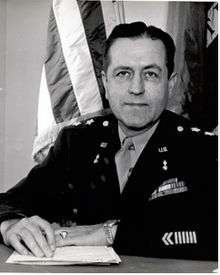Henry Benton Sayler
| Henry Benton Sayler | |
|---|---|
 | |
| Born |
November 4, 1893 Huntington, Indiana |
| Died |
May 7, 1970 (aged 76) Savannah, Georgia |
| Allegiance |
|
| Service/branch |
|
| Years of service | 1915 - 1949 |
| Rank |
|
| Commands held | Chief Ordnance Officer, ETO |
| Battles/wars | |
| Awards |
Distinguished Service Medal Legion of Merit Bronze Star Medal (2) |
Henry Benton Sayler (November 4, 1893 – May 7, 1970) was a United States Army officer with the rank of Major General. During the World War II, Sayler served as a Chief of Ordnance Officer of the European Theater of Operations.
Early military career
Henry Benton Sayler was born on November 4, 1893 in Huntington, Indiana. He attended the Braden’s Preparatory School in Highland Falls, New York and subsequently was appointed at United States Military Academy at West Point, New York in 1911. Sayler graduated four years later as a part of "the class the stars fell on" (because 59 members of this class became general officers). For example: Dwight D. Eisenhower, Omar N. Bradley, James Van Fleet, Henry Aurand, Stafford LeRoy Irwin, John W. Leonard or others. He was commissioned a Second lieutenant in Coast Artillery Corps on June 12, 1915.[1]
In 1921, he was transferred to the Ordnance Corps and subsequently served on various military posts across United States. Between years 1931-1937, Sayler served as a Member of the Cavalry Board. Sayler also attended the Command and General Staff College at Fort Leavenworth, Kansas in 1931.[2]
In 1937, he was appointed a Chief of General Supply Division in the Office of the Chief of Ordnance and served in this capacity until the end of next year, when he was assigned to the 4th Corps Area as its Ordnance officer. Then he was appointed an Ordnance officer of the First Army under the command of Lieutenant general Hugh Aloysius Drum.[3]
World War II
With the United States entry into the War, Sayler's old West Point Classmate, now Commanding General of the U.S. Forces in the European Theater of Operations, Dwight D. Eisenhower, appointed him as Chief Ordnance Officer of ETO. In this capacity, Eisenhower tasked him to plan, assemble, and execute the logistical support for the North African invasion.[4]
During D-Day invasion he solved many problems which include waterproofing of vehicles and disposing bombs which didn't explode. Due to his great work at that time, U.S. Forces was one of the best equipped fighting force in the history of warfare.[5] Sayled stayed in this capacity until 1945, when he was appointed an Assistant Chief of Ordnance, deputy of Lieutenant general, Levin H. Campbell, Jr.
For his service during the War, Sayler was decorated with the Army Distinguished Service Medal, Legion of Merit and with two Bronze Star Medals.[6]
After the war, he was given a position as a chief at the Research and development, Ordnance Department. Sayler retired from the Army with the rank of Major general in 1949. Major general Henry B. Sayler died on May 7, 1970 at the age of 76 in Savannah, Georgia. He is buried together with his wife Jessie Sayler (1896 - 1987) at Arlington National Cemetery in Virginia.[7]
Decorations
Here is the ribbon bar of Major general Henry B. Sayler:
References
- ↑ "Sayler, Henry B. papers" (PDF). Eisenhower Archives.gov. Retrieved August 18, 2013.
- ↑ "Biography of Major General Henry Benton Sayler (1893 - 1970), USA". generals.dk. Retrieved August 18, 2013.
- ↑ "Biography of Major General Henry Benton Sayler (1893 - 1970), USA". generals.dk. Retrieved August 18, 2013.
- ↑ "Major General Henry B. Sayler - Ordnance Corps Hall of Fame Inductee 1984, U.S.Army Ordnance Corps". goordnance.army.mil. Retrieved August 18, 2013.
- ↑ "Major General Henry B. Sayler - Ordnance Corps Hall of Fame Inductee 1984, U.S.Army Ordnance Corps". goordnance.army.mil. Retrieved August 18, 2013.
- ↑ "Henry B. Sayler". Military Times. Retrieved July 22, 2013.
- ↑ "Henry Benton Sayler (1893-1970) - Find a Grave Memorial". Find a Grave. Retrieved August 18, 2013.